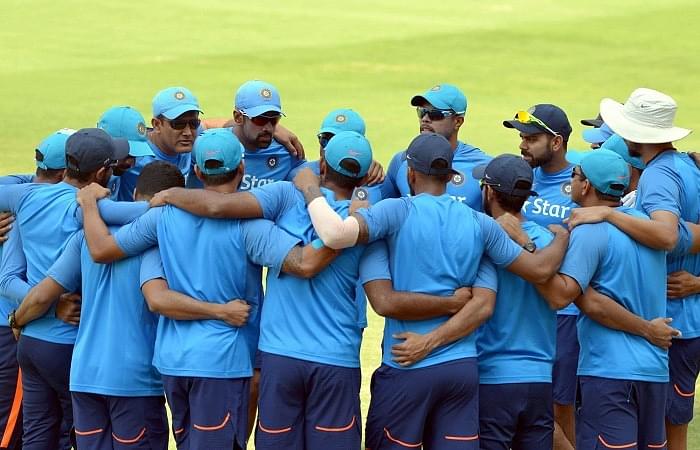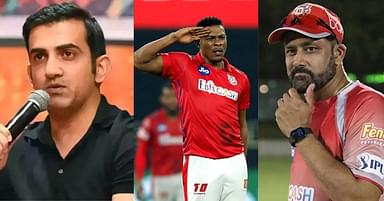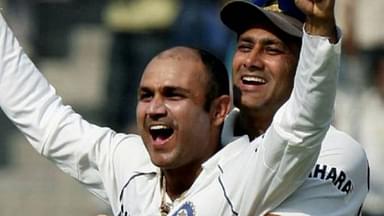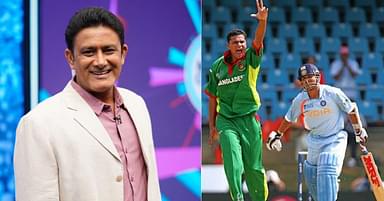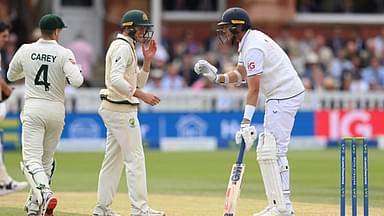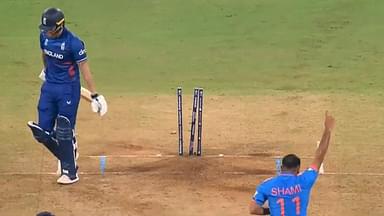When you think about Indian cricketers, what is the first thing that comes to mind. Brave and honourable souls who protect the country’s honour? Overpaid, under worked privileged sportspersons, who make a merry living? Maybe. Maybe not. But, the one thing that we all can agree on is the fact that Indian cricketers are the richest in the world. That India has the highest paid cricketers in the world. Or do we?
Advertisement
The past few months have seen several high profile money wrangling cases in the world of cricket. The BCCI has been waging a lone war against the ICC, and their fellow full members, for a higher share of the revenues accrued by the ICC.
The Australian cricketers have refused to sign on the dotted line of their national contracts. They have even threatened to go on strike, after June 30. Although technically, since they will be out of contract (read unemployed), they will not have the ability to go on strike.
Closer to home, India’s very own national team players are trying to negotiate a higher annual salary. This has led to a lot of raised eyebrows and snide comments. Surely, the highest paid cricketers in the world (read Indian) do not need to be paid more. They already make more than they deserve. Don’t they?

How much are they paid
Now, before we delve any further, we need to understand the primary modes of income for an Indian cricketer. And here, we are not going to consider the income from endorsements, etc which do not come from the BCCI. Nor will we take into account their IPL salaries, because that is a different entity altogether.
For a national team cricketer, the 2 main modes of income are the central contracts and the match fees. Indian cricketers’ contracts are divided into 3 categories: A, B and C. The annual salaries for the same are INR 2 crores, 1 crore and 50 lakhs respectively. The match fees are different for all 3 formats. We will study them all in detail later on.
But, how do these salaries compare to their international counterparts? Surely, our guys are the highest paid cricketers in the world. Aren’t they?
Separating fact from fiction
BCCI’s contracts run from 1st October to 30th September. For the 2016-17 season, 32 cricketers were awarded national contracts. Seven in Category A, Nine in Category B and sixteen in C. The big news coming in was the fact that the retainers for all 3 categories had been doubled from their previous values.
Coming to the international scene, Australia award national contracts to their top 20 men’s cricketers. All of them receive the same salary. Currently, it stands at AUD 900,000. Which roughly translates to INR 4.5 crores.
Comparatively, a Category A Indian cricketer will receive INR 2 crore per year. And he is the highest paid in the country. Also, this figure has been revised this season. Earlier, it was INR 1 crore. Surprised? Still think our boys are the highest paid cricketers in the world? Wait for the next one.
England employ a slightly complicated system. They have provisions for 2 different types of contracts: Test cricket contracts and white ball contracts for limited overs players. And how much are these worth?
For starters, the test cricket contracts pay GBP 700,000. Which is a whooping INR 5.95 crores. The white ball contracts are relatively modest, paying around GBP 190,000. Which is still over INR 1.6 crores. And it is to be noted that the white ball contract holders are allowed to retain their county salaries, which for the uninitiated, is a significant sum.
But what really takes the cake is the case of those English cricketers who play all formats. There aren’t many of those, due to England’s policy of insulating formats and picking horses for courses. But the precious four, Joe Root, Ben Stokes, Moeen Ali and Chris Woakes, were awarded both Test cricket and white ball contracts. I will leave the readers to calculate their total income.

Also, the captains of both countries traditionally receive 25% extra on their base salary, due to taking on the added pressure of captaincy. You might have wondered why Anil Kumble was making a case for Virat Kohli to be paid an extra 25%. There you go.
The contractual salaries of all 3 country’s players is summarised below.
| National contracts for International men’s cricketers | |||
| India (2016-17 onwards) | Grade C
| Grade B | Grade A |
| INR 50 lakhs | INR 1 crore | INR 2 crores | |
| India (before 2016-17)
| Grade C
| Grade B | Grade A |
| INR 25 lakhs | INR 50 lakhs | INR 1 crore | |
| England (1 GBP = 85 INR)
| White ball contracts
| Test cricket contracts | Both combined |
| INR 1.615 crores | INR 5.95 crores | INR 7.565 crores | |
| Australia (1 AUD = 50 INR) | INR 4.5 crores | ||
Match fees
At the beginning of the home season, the BCCI decided to double the value of the current existing Test match fees, from INR 7.5 lakhs per match to 15 lakhs. Subsequently, the match fees for limited overs matches was also increased from INR 4 lakhs to 6 lakhs for ODIs and INR 2 lakhs to 3 lakhs for T20 Internationals.
English cricketers are paid GBP 12,000, 5,000 and 2,500 respectively for the 3 formats. Australian cricketers are paid AUD 14,000, 7,000 and 5,000 respectively. The equivalent figures in INR are given in the table below.
At least, in this case Indian cricketers currently earn more than their international counterparts.
| Match Fees (INR) | Test matches | ODIs | T20 Internationals |
| India (2016-17 onwards) | 15 lakhs | 6 lakhs | 3 lakhs |
| India (before 2016-17) | 7 lakhs | 4 lakhs | 2 lakhs |
| England (1 GBP = 85 INR) | 10.2 lakhs | 4.25 lakhs | 2.125 lakhs |
| Australia (1 AUD = 50 INR) | 7 lakhs | 3.5 lakhs | 2.5 lakhs |
Domestic cricketers
Another case recently in the limelight is ace off spinner, Harbhajan Singh’s impassioned plea to head coach, Anil Kumble, to request a review of salaries in domestic cricket.
India’s domestic cricketers, shockingly, do not have annual contracts. How obsolete this process is can be gauged from the fact that the Sri Lankan Cricket Board, one of the poorest in the world, sanctioned contracts for 70 domestic cricketers this season.
The fact of the matter is that playing cricket professionally is not a secure financial option, until and unless you make it to the top. This is despite BCCI being the richest cricket board in the world. And making to the top is certainly not easy in a country of 1.3 billion, is it?
Women cricketers
Women’s cricket has been traditionally ignored, even ridiculed, in India. There have been a few positive changes of late. In 2015-16, the BCCI made the long overdue decision to award central contracts to women cricketers. This was followed by the institution of the ‘Lifetime Achievement Award’ for Women cricketers from this season.

Also, earlier this season the daily allowance for women cricketers was brought to parity with their men’s counterparts. Incidentally, this amount is USD 100 for home matches and USD 125 for overseas tours.
However, a lot more needs to be done to improve the state of the women’s game. For starters, India is yet to have a T20 league for women on the lines of the IPL. It must be remembered that when it came to men’s cricket, BCCI were the first to jump on to the T20 bandwagon.
Author’s take
A lot of people would argue that our cricketers already earn much more than the common people. So why pay them more?
At the risk of repeating myself, for the simple reason that the BCCI is the richest cricket board in the world. Their gross revenue and net income far outstrips any other country’s cricket board. And remember, every rupee that comes into the BCCI is because of the cricketers. The BCCI can claim to have increased revenue by marketing activities. But, cricket in India does not have to be pushed. People are ready to consume it and pay handsomely for it.
Since, BCCI is the richest cricket board in the world, for this very reason, India’s players should undoubtedly have the privilege of being the highest paid cricketers in the world. In fact, it is surprising that it has taken this long for India’s cricketers to wake up to the reality and demand their fair share.
One reason is obviously the lack of a players association. This can be attributed to BCCI’s mistrust of increasing player power right from the days of the late Jagmohan Dalmiya. However, this looks set to change soon, as one of the Lodha Committee recommendations asks the BCCI to form a players association with haste.
Coming back to salaries, earnings from endorsements are personal and vary from cricketer to cricketer. Remember, not every cricketer is able to earn big bucks by endorsing products. Moreover, this income is in no way related to the BCCI’s corpus.
The IPL salaries too vary from person to person. Someone like Cheteshwar Pujara has been unable to earn an IPL contract for the past couple of seasons. Also, it is to be noted that most major overseas players are able to boost their earnings by plying their trade in the IPL. Indian cricketers are not the only ones benefiting. Remember Ben Stokes pocketed a cool INR 14 crore for his exploits in the IPL.
Moreover, the BCCI forbids Indian cricketers (even non contracted ones) from taking part in overseas T20 tournaments. Someone like AB de Villiers or Steve Smith definitely has an advantage here. An Australian cricketer, for example, is able to double his wages by playing the IPL as well as the Big Bash League (BBL).
The one positive aspect in India is the fact that the total number of centrally contracted players (32) is more than that of any country in the world.
Now, exactly how much should Indian cricketers be paid? I’ll leave that to your judgement.

